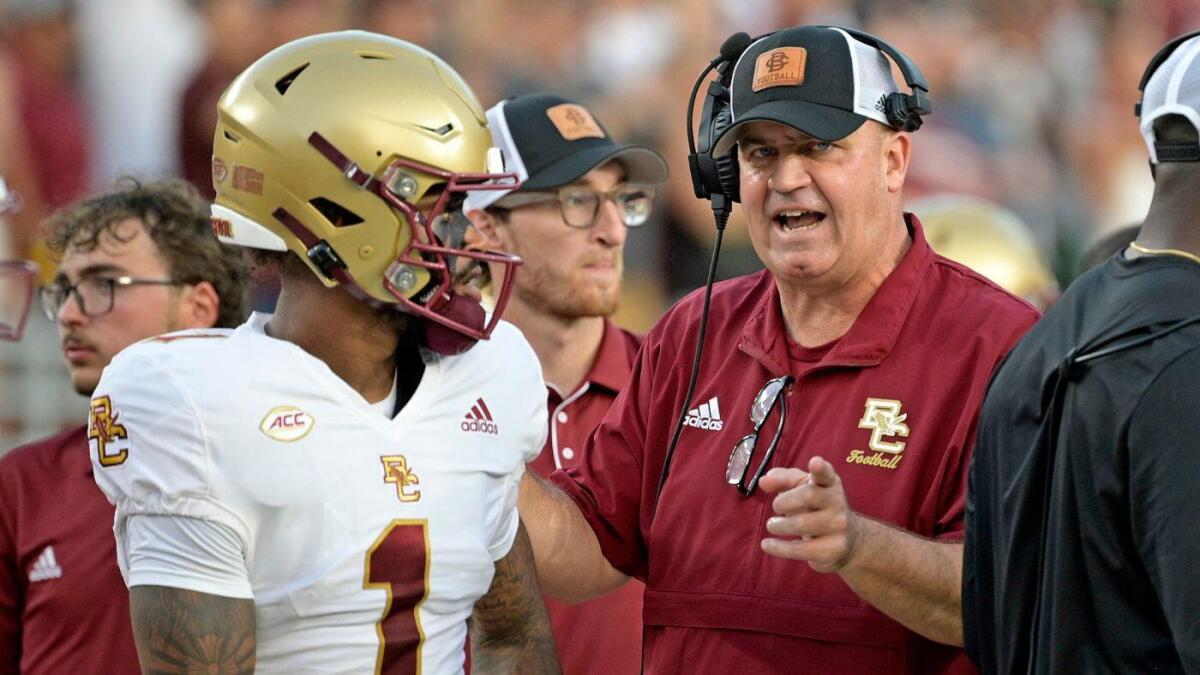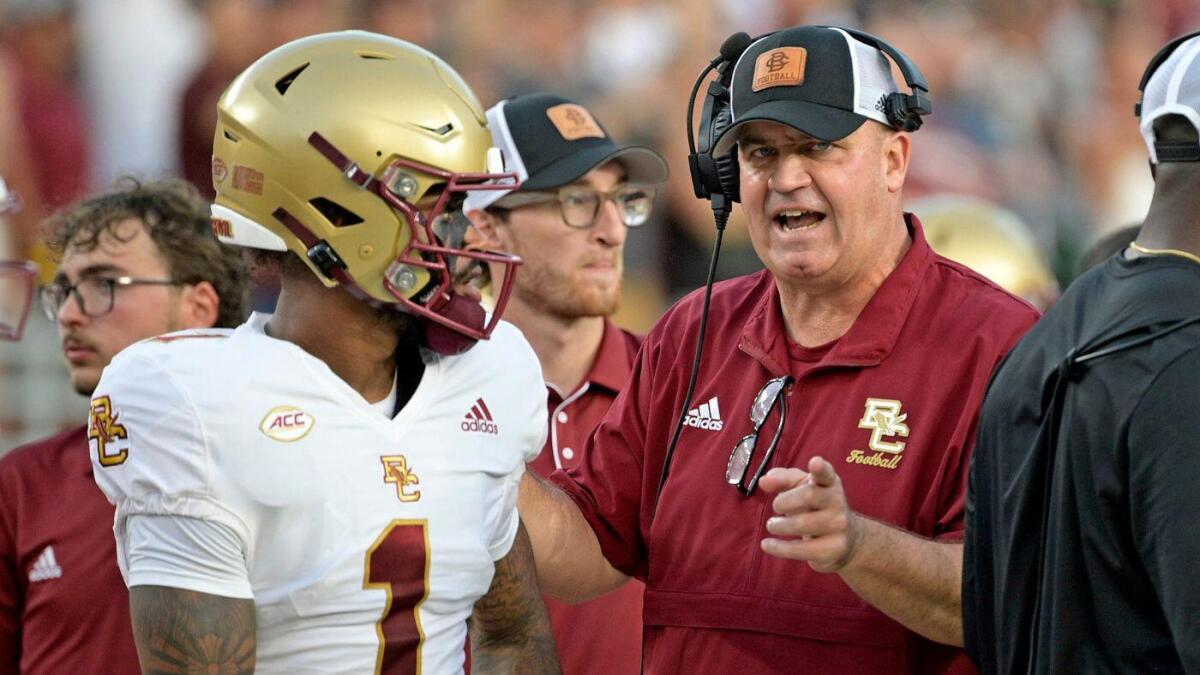The Quarterback Controversy: A Breakdown of the O’Brien-Castellanos Fallout
Introduction: The Drama Unfolds
College football is a world where talent, ambition, and ego collide, often resulting in dramatic narratives that captivate fans and analysts. One such narrative unfolded between Florida State University (FSU) quarterback Thomas Castellanos and his former head coach at Boston College (BC), Bill O’Brien. Their public disagreement, sparked by Castellanos’s departure from BC, has become a focal point of discussion, offering a glimpse into the complexities of player-coach relationships in modern college football.
The Seeds of Discord: Castellanos’s Time at Boston College
Thomas Castellanos arrived at Boston College with the promise of a bright future. His tenure was marked by moments of brilliance, but also by the inevitable scrutiny that comes with being a young quarterback in a high-pressure environment. The BC fanbase, known for its passionate and sometimes critical nature, oscillated between praise and criticism, a dynamic that Castellanos had to navigate carefully.
However, the trajectory of Castellanos’s career at BC took a dramatic turn when Jeff Hafley, the head coach who recruited him, departed. Hafley’s exit was a significant blow, as it disrupted the established dynamic between coach and player. This event set the stage for a series of decisions and misunderstandings that would ultimately lead to Castellanos’s transfer.
The Benching and the Breakup: A Turning Point
The situation escalated when Bill O’Brien, the new head coach at Boston College, made the decision to bench Castellanos in favor of Grayson James. This move was a pivotal moment, not just for Castellanos’s career, but also for the team’s dynamics. The benching triggered a chain reaction that resulted in Castellanos stepping away from the team.
Initially, reports suggested a mutual parting, but the narrative soon shifted as both O’Brien and Castellanos began to voice their perspectives publicly. This public airing of grievances added fuel to the fire, creating a media frenzy that captivated fans and analysts alike.
Castellanos Speaks Out: “I Wasn’t Repaid the Right Way”
After transferring to Florida State, Castellanos opened up about his reasons for leaving Boston College. In a candid interview, he expressed feeling “not repaid the right way,” suggesting a lack of support or opportunity under the new coaching regime. He implied that O’Brien played a significant role in his decision to transfer, indicating a breakdown in their relationship and a divergence in their vision for the team’s future.
Castellanos directly challenged the narrative that he quit on his team, arguing that the circumstances surrounding his benching and the subsequent lack of support forced his hand. He felt the need to find a program where his talents would be better utilized and appreciated. His comments highlighted the importance of player-coach relationships and the impact they can have on a player’s career.
O’Brien’s Rebuttal: Accusations of Quitting
Bill O’Brien, known for his straightforward and sometimes blunt communication style, didn’t shy away from responding to Castellanos’s claims. He reportedly referred to Castellanos as an “outlier” and didn’t hold back when discussing the quarterback’s midseason departure. O’Brien directly contradicted Castellanos’s version of events, suggesting that the quarterback had, in fact, quit on the team after losing his starting job.
O’Brien emphasized that Castellanos’s decision to leave negatively impacted the team and disrupted the team’s chemistry. He implied that he had made the decision to bench Castellanos because he believed Grayson James offered a better chance for the team to win. O’Brien’s response underscored the high stakes of coaching decisions and the potential fallout when they go awry.
Trading Barbs: A Public Spat
The back-and-forth between Castellanos and O’Brien quickly escalated into a public spat, with both sides trading barbs through media outlets. This created a media frenzy, fueling speculation and debate among fans and analysts. The controversy added fuel to the fire of the already intense rivalry between Boston College and Florida State.
The public nature of the dispute highlighted the challenges of managing player-coach relationships in the age of social media and instant news cycles. It also raised questions about the role of the media in amplifying conflicts and shaping public perception.
The Impact on Boston College
O’Brien’s decision to bench Castellanos and the subsequent controversy undoubtedly impacted Boston College. While some argue that the team improved after the quarterback change, the public dispute could have created a distraction and potentially affected team morale. Furthermore, O’Brien’s handling of the situation could influence future recruits’ perceptions of the program.
Potential recruits may question O’Brien’s player management skills and his ability to foster a positive team environment. The controversy also raised questions about the long-term impact on the team’s culture and the ability to attract and retain top talent.
Castellanos’s New Chapter at FSU
For Thomas Castellanos, the transfer to Florida State represents a fresh start and an opportunity to prove himself in a new environment. He has already begun turning heads at FSU, impressing coaches and teammates with his talent and work ethic. This new beginning could be a chance for Castellanos to showcase his skills on a bigger stage.
Castellanos’s move to FSU also highlights the growing trend of players using the transfer portal to seek out new opportunities. The transfer portal has become a powerful tool for players, giving them more agency and control over their careers. However, it also comes with its own set of challenges and uncertainties.
The Underlying Issues: Coaching Styles and Player Expectations
The O’Brien-Castellanos fallout highlights the complex dynamics between college coaches and players. It underscores the importance of clear communication, mutual respect, and shared vision. Different coaching styles and varying expectations can often lead to friction and conflict, especially in high-pressure environments like college football.
In this specific case, it appears that there was a fundamental disconnect between O’Brien’s vision for the team and Castellanos’s expectations for his role within the program. This disconnect highlights the need for coaches to understand and address the individual needs and aspirations of their players.
Navigating the Transfer Portal Era
The rise of the transfer portal has further complicated these dynamics, giving players more agency and freedom to seek out new opportunities. While the transfer portal can be beneficial for both players and programs, it also creates the potential for increased instability and turnover. Coaches must now navigate the delicate balance between maintaining a cohesive team and accommodating players’ individual aspirations.
The transfer portal also raises questions about the long-term impact on player development and team culture. As more players use the portal to seek out new opportunities, coaches must adapt their strategies to attract and retain top talent.
Conclusion: A Cautionary Tale
The Thomas Castellanos-Bill O’Brien saga serves as a cautionary tale about the potential pitfalls of miscommunication, differing expectations, and the complexities of the modern college football landscape. While both individuals have moved on to new chapters in their careers, the controversy serves as a reminder of the human element in sports and the importance of fostering positive relationships between coaches and players.
Ultimately, this situation highlights the need for empathy, understanding, and effective communication in navigating the ever-evolving world of college athletics. It also underscores the importance of adaptability and resilience in the face of change and uncertainty. As the landscape of college football continues to evolve, the lessons learned from this controversy will be invaluable for coaches, players, and programs alike.












